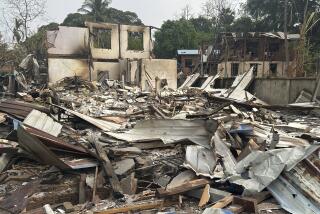Year of Burmese Protests Culminated in Coup
- Share via
\o7 RANGOON, Burma\f7 — Here is a chronology of events leading to military commander Saw Maung’s ouster of civilian President Maung Maung:
September, 1987--Government makes 80% of currency worthless, sparking first big street protests in 13 years.
March, 1988--Rioters storm through Rangoon setting fire to buildings and vehicles in weeklong disturbances after death of student in brawl.
June--Demonstrations spread to Mandalay and other cities as Burmese protest one-party rule, government repression, economic stagnation and Burma’s isolation. Nine die in “rampage of destruction” in Rangoon.
July 16--Government admits 41 Rangoon students suffocated to death in police van in March. Prime Minister Maung Maung Kha resigns.
June 21--Rangoon put under 60-day curfew.
July 23--Ne Win, who had ruled Burma since a 1962 coup, resigns as chairman of the only political party, the Burma Socialist Program Party, and announces a referendum on one-party rule.
July 26--Sein Lwin, hard-line former security chief, named party chairman and president.
Aug. 8-11--Tens of thousands march in Rangoon and 14 other cities, and security troops fire on protesters. Government reports 112 killed in anti-government riots; others say hundreds died.
Aug. 12--Sein Lwin resigns after 17 days in office.
Aug. 19--Maung Maung, 63-year-old former judge, named to lead Burma.
Aug. 24--Maung Maung lifts martial law and curfews in Rangoon and other cities and announces a Sept. 12 congress of the ruling party to consider a referendum on multi-party elections.
Aug. 26--Aung San Suu Kyi, daughter of national hero Aung San, tells mass rally that government should resign. At least 57 inmates die in riot at Rangoon’s Insein jail; unofficial accounts say 400 to 700 killed.
Aug. 27--Former Defense Minister Tin Oo and other former officers call for interim government.
Aug. 29--U Nu, first prime minister after independence, and 20 leading Burmese form first major anti-government alliance.
Sept. 1--Independent newspapers appear, government press throws off censorship, radio and TV remain in the control of ruling party. Crowds march in Rangoon at start of general strike.
Sept. 8--Estimated 1 million people hold demonstrations and strikes.
Sept. 10--Ruling party declares an end to its monopoly of power and calls for multi-party elections at an unspecified date.
Sept. 12--Protesters reject plan for election under existing government. Defense Minister Saw Maung reaffirms army support for ruling party.
Sept. 16--Half a million people take to Rangoon streets for third consecutive day. Government directs all troops, police and civil servants to resign from ruling party to ensure free elections.
Sept. 17--Opposition scorns government move. Troops fire at demonstrators, wounding three.
Sept. 18--Rangoon Radio announces military takeover.
More to Read
Sign up for Essential California
The most important California stories and recommendations in your inbox every morning.
You may occasionally receive promotional content from the Los Angeles Times.










